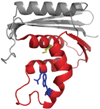The folding trajectory of RNase H is dominated by its topology and not local stability: a protein engineering study of variants that fold via two-state and three-state mechanisms
- PMID: 19501596
- PMCID: PMC2865250
- DOI: 10.1016/j.jmb.2009.05.085
The folding trajectory of RNase H is dominated by its topology and not local stability: a protein engineering study of variants that fold via two-state and three-state mechanisms
Abstract
Proteins can sample a variety of partially folded conformations during the transition between the unfolded and native states. Some proteins never significantly populate these high-energy states and fold by an apparently two-state process. However, many proteins populate detectable, partially folded forms during the folding process. The role of such intermediates is a matter of considerable debate. A single amino acid change can convert Escherichia coli ribonuclease H from a three-state folder that populates a kinetic intermediate to one that folds in an apparent two-state fashion. We have compared the folding trajectories of the three-state RNase H and the two-state RNase H, proteins with the same native-state topology but altered regional stability, using a protein engineering approach. Our data suggest that both versions of RNase H fold through a similar trajectory with similar high-energy conformations. Mutations in the core and the periphery of the protein affect similar aspects of folding for both variants, suggesting a common trajectory with folding of the core region followed by the folding of the periphery. Our results suggest that formation of specific partially folded conformations may be a general feature of protein folding that can promote, rather than hinder, efficient folding.
Figures











Similar articles
-
A single mutation at residue 25 populates the folding intermediate of E. coli RNase H and reveals a highly dynamic partially folded ensemble.J Mol Biol. 2009 Aug 14;391(2):461-70. doi: 10.1016/j.jmb.2009.05.084. Epub 2009 Jun 6. J Mol Biol. 2009. PMID: 19505477 Free PMC article.
-
Destabilization of the Escherichia coli RNase H kinetic intermediate: switching between a two-state and three-state folding mechanism.J Mol Biol. 2004 Jan 9;335(2):609-18. doi: 10.1016/j.jmb.2003.10.052. J Mol Biol. 2004. PMID: 14672667
-
The burst-phase folding intermediate of ribonuclease H changes conformation over evolutionary history.Biopolymers. 2018 Aug;109(8):e23086. doi: 10.1002/bip.23086. Epub 2017 Nov 20. Biopolymers. 2018. PMID: 29152711 Free PMC article.
-
Disulfide bonds and protein folding.Biochemistry. 2000 Apr 18;39(15):4207-16. doi: 10.1021/bi992922o. Biochemistry. 2000. PMID: 10757967 Review.
-
Touring the landscapes: partially folded proteins examined by hydrogen exchange.Structure. 1997 Jul 15;5(7):859-63. doi: 10.1016/s0969-2126(97)00240-2. Structure. 1997. PMID: 9261079 Review.
Cited by
-
The folding and unfolding behavior of ribonuclease H on the ribosome.J Biol Chem. 2020 Aug 14;295(33):11410-11417. doi: 10.1074/jbc.RA120.013909. Epub 2020 Jun 11. J Biol Chem. 2020. PMID: 32527724 Free PMC article.
-
The folding of single domain proteins--have we reached a consensus?Curr Opin Struct Biol. 2011 Feb;21(1):12-24. doi: 10.1016/j.sbi.2010.11.002. Epub 2010 Dec 6. Curr Opin Struct Biol. 2011. PMID: 21144739 Free PMC article. Review.
-
Tracing a protein's folding pathway over evolutionary time using ancestral sequence reconstruction and hydrogen exchange.Elife. 2018 Sep 11;7:e38369. doi: 10.7554/eLife.38369. Elife. 2018. PMID: 30204082 Free PMC article.
-
The H2A-H2B dimeric kinetic intermediate is stabilized by widespread hydrophobic burial with few fully native interactions.J Mol Biol. 2012 Jan 20;415(3):600-14. doi: 10.1016/j.jmb.2011.11.032. Epub 2011 Nov 23. J Mol Biol. 2012. PMID: 22137897 Free PMC article.
-
Non-native structure appears in microseconds during the folding of E. coli RNase H.J Mol Biol. 2015 Jan 30;427(2):443-53. doi: 10.1016/j.jmb.2014.10.003. Epub 2014 Oct 13. J Mol Biol. 2015. PMID: 25311861 Free PMC article.
References
-
- Jahn TR, Radford SE. The Yin and Yang of protein folding. FEBS J. 2005;272:5962–5970. - PubMed
-
- Matouschek A, Kellis JT, Jr, Serrano L, Fersht AR. Mapping the transition state and pathway of protein folding by protein engineering. Nature. 1989;340:122–126. - PubMed
-
- Plaxco KW, Simons KT, Baker D. Contact order, transition state placement and the refolding rates of single domain proteins. J Mol Biol. 1998;277:985–994. - PubMed
Publication types
MeSH terms
Substances
Grants and funding
LinkOut - more resources
Full Text Sources
Molecular Biology Databases

